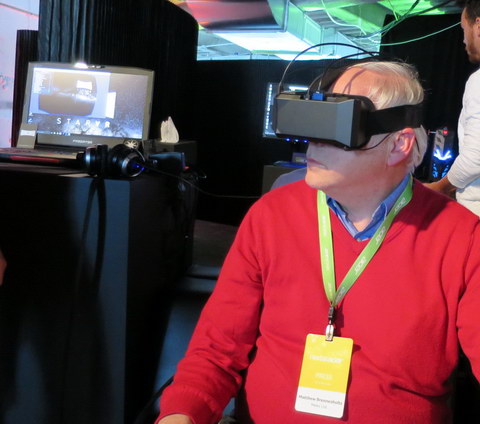Acer Inc. announced on June 25th its intent to acquire convertible bonds issued by Starbreeze AB, a computer game developer and VR company based in Stockholm, Sweden, through a private placement transaction. Starbreeze and Acer have reached a term sheet whereby Starbreeze will issue US$9 million (SEK 74.3 million) in a two-year bond convertible to B-shares to Acer Inc. and/or its affiliates under the Board’s mandate.
Jason Chen, Corporate President and CEO, Acer Inc. with Bo Andersson-Klint, CEO, Starbreeze AB.
As part of its long-term strategic investments, Acer expects the investment in Starbreeze to further solidify the collaboration between the two companies. It will also enhance Acer’s position in the virtual reality (VR) ecosystem, which Acer believes has a huge potential beyond PC gaming. The company believes VR is set to unlock new possibilities for many other industries such as entertainment, retail, transportation, and education.
The term sheet forms the basis for ongoing discussions regarding a definitive agreement, subject to Board approval by both companies. The bond will have a coupon not exceeding an interest cost of 2% per year. Acer may convert the bond into B-shares at a conversion price determined by the 60-day average share price prior to June 24. Based on the number of outstanding shares on June 25th, the bond would, upon conversion, approximately correspond to 1.6% of the share capital and 0.5 % of the votes based on recent SEK to USD and stock price quotations.
“Acer’s investment directly into Starbreeze will greatly benefit our long term VR-strategy and further solidify the collaboration between our companies and additionally enrich our eco-system,” said Bo Andersson-Klint, Starbreeze CEO.
Acer also reconfirmed the previous announcement of the agreement between Acer and Starbreeze to form a joint venture for the design, manufacturing, promotion, marketing and sales of the StarVR Virtual Reality (VR) Head-Mounted Display (HMD). Starbreeze’s primary business is development of gaming software.
Andersson-Klint commented on the JV by saying “Our strategic alignment with Acer is going to exponentially improve the StarVR HMD in terms of quality, execution and market reach. Together, we will keep pushing the frontier of VR technology. With the Acer production partnership for the StarVR headset, our joint venture with IMAX for location-based entertainment, and the content platform collaboration with Smilegate, we now have a perfect ecosystem for our VR centers.”
 Meko’s Matt Brennesholtz testing the StarVR prototype headset at the Next@Acer press conference in April
Meko’s Matt Brennesholtz testing the StarVR prototype headset at the Next@Acer press conference in April
At the Acer global press conference in April, I saw demonstrations of four different VR HMDs: the StarVR unit from Strarbreeze, the Oculus Riftheadset from Oculus, Open Source Virtual Reality’s OSVRheadset and HTC’s Vive. At the time Acer’s interest appeared to be showing how the company’s new Predator series desktop and laptop gaming computers, with advanced Nvidia GPUs, could drive a variety of VR headsets with good image quality, high frame rates and low latency.
When I tried all four headsets, the StarVR unit clearly had superior image quality compared to the other three HMDs and it now appears as though Acer agrees with me. This image quality was largely based on the fact that the StarVR unit is based on two high-resolution displays, one for each eye, while the other units use a single display which is shared by the two eyes.
While it is intuitively obvious that two displays and the 2x pixel count would provide better image quality than a single shared display, the two display approach also has problems. First, it is likely to be more expensive than an HMD with a single display since the display itself is a large part of the HMD manufacturing cost. Second, the two display approach will be heavier and more bulky than an HMD based on a single display. It remains to be seen if the advantages of improved image quality will outweigh the cost and weight disadvantages of the StarVR system in the VR headset market.
At CE Week in New York on June 23rd, Tom Emrich, producer of Augmented World Expo, said to be “the largest event dedicated to AR, VR and wearable technology,” moderated a conference session titled “The New Reality is Virtual and Augmented. Ready?” In his opening remarks, he mentioned that in the past year there has been about $1 billion invested in VR and AR around the world. Acer and Starbreeze can expect plenty of competition in the market for the StarVR headset, so the question of one vs. two displays is likely to be settled by the marketplace in the coming years.
– Matthew Brennesholtz

